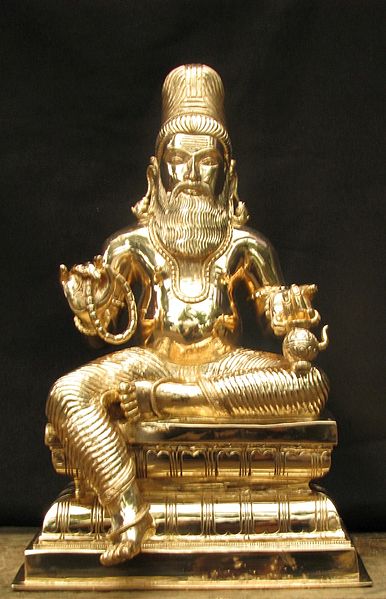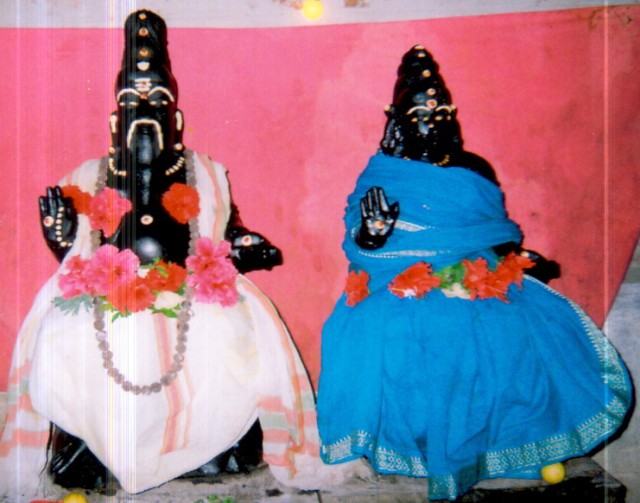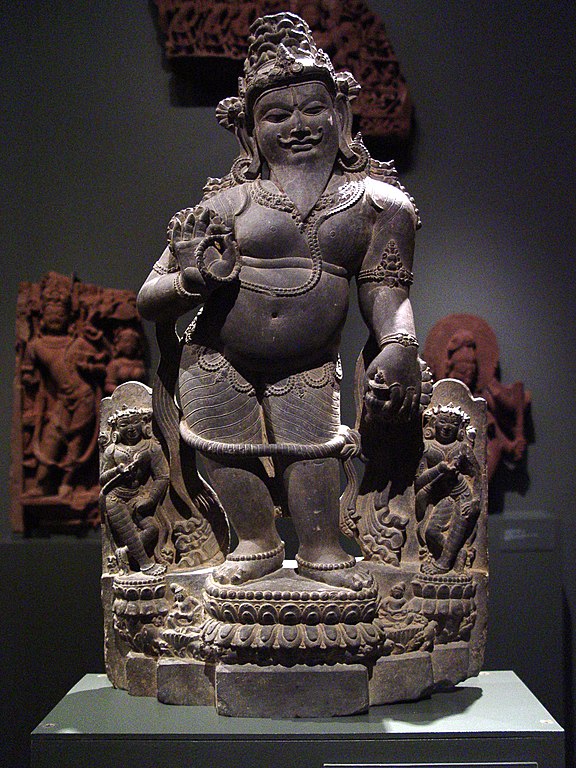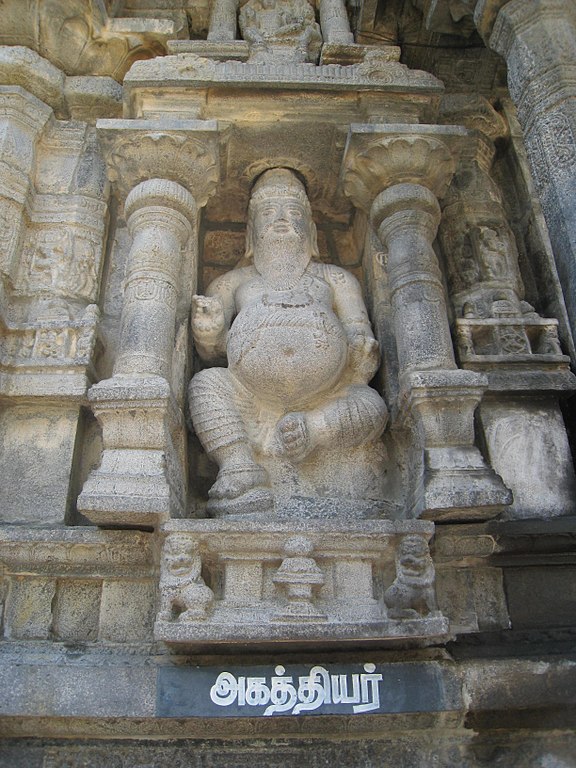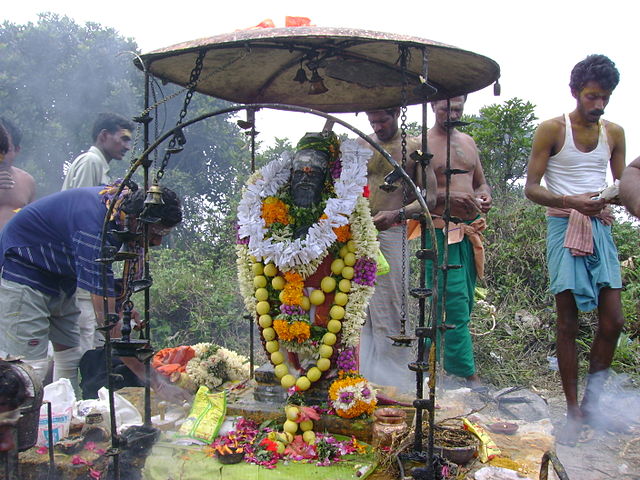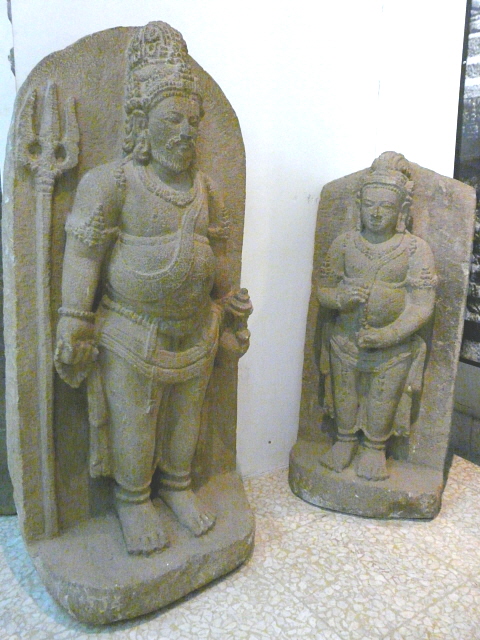
| AGASTYA
Agastya Title
: Natural Medicinal Scientist, Siddha
Agastya was a revered Vedic sage of Hinduism. In the Indian tradition, he is a noted recluse and an influential scholar in diverse languages of the Indian subcontinent. He and his wife Lopamudra are the celebrated authors of hymns 1.165 to 1.191 in the Sanskrit text Rigved and other Vedic literature.
In Valmiki Ramayan, it is stated that Asurs hid inside the ocean so that the Devs couldn’t harm them. The Devs requested Rishi Agastya for help, and he drank the entire ocean using his austerity and mystic powers. The Devs killed the Asurs, and asked the sage to return the ocean’s water. The water was returned by river Ganga post penance of Bhagirath.
In some scriptures, it is stated that during Lord Shiv’s marriage, everyone in the universe went to witness the event in the Himalayas, in the North. Bhumi Devi or the Earth Goddess was not able to bear this misbalance and prayed to Lord Shiv for help, who then told Agastya to go to the south end. Rishi Agastya went to the south and the earth’s balance was restored. On one side there was the entire universe and on the other side was Agastya, whose austerity power and aura balanced the earth.
Agastya appears in numerous itihasas and purans including the major Ramayan and Mahabharat. He is one of the seven or eight most revered rishis (the Saptarishi) in the Vedic texts, and is revered as one of the Tamil Siddhar in the Shaivism tradition, who invented an early grammar of the Tamil language, Agattiyam, playing a pioneering role in the development of Tampraparniyan medicine and spirituality at Saiva centres in proto-era Sri Lanka and South India. He is also revered in the Puranic literature of Shaktism and Vaishnavism. He is the one who was created by Siva to offer boons to Kaliyan. He is one of the Indian sages found in ancient sculpture and reliefs in Hindu temples of South Asia, and Southeast Asia such as in the early medieval era Shaiva temples on Java Indonesia. He is the principal figure and Guru in the ancient Javanese language text Agastyaparva, whose 11th century version survives.
Agastya is traditionally attributed to be the author of many Sanskrit texts such as the Agastya Gita found in Varah Puran, Agastya Samhita found embedded in Skand Puran, and the Dvaidha-Nirnaya Tantra text. He is also referred to as Maan, Kalasaj, Kumbhaj, Kumbhayoni and Maitravaruni after his mythical origins.
Etymology and nomenclature :
Sage Agastya in seated posture. This sculpture is from Angkor period, Cambodia, ca.975 AD. The etymological origin of Agastya has several theories. One theory states that the root is Aj or Anj, which connotes "brighten, effulgent one" and links Agastya to "one who brightens" in darkness, and Agastya is traditionally the Indian name for Canopus, the second most brilliantly shining star found in South Asian skies, next to Sirius. A third theory links it to Indo-European origins, through the Iranian word gasta which means "sin, foul", and a-gasta would mean "not sin, not foul". The fourth theory, based on folk etymology in verse 2.11 of the Ramayan states that Agastya is from aga (unmoving or mountain) and gam (move), and together these roots connote "one who is mover-of-mountains", or "mover-of-the-unmoving". The word is also written as Agasti and Agathiyar.
Biography :
Maharishi Agastya and Lopamudra Agastya is the named author of several hymns of the Rigved. These hymns do not provide his biography. The origins of Agastya - Pulastya, one of the Rig Vedic Saptarishis is his father. His miraculous rebirth follows a yajna being done by gods Varun and Mitra, where the celestial apsara Urvashi appears. They are overwhelmed by her extraordinary sexuality, and ejaculate. Their semen falls into a mud pitcher, which is the womb in which the fetus of Agastya grows. He is born from this jar, along with his twin sage Vashisth in some mythologies. This mythology gives him the name kumbhayoni, which literally means "he whose womb was a mud pot".
Agastya is a Brahmin who leads an ascetic life, educates himself, becoming a celebrated sage. His unknown origins have led to speculative proposals that the Vedic-era Agastya may have been a migrant whose ideas influenced the south.
According to inconsistent legends in the Puranic and the epics, the ascetic sage Agastya proposed to Lopamudra, a princess born in the kingdom of Vidharbh. Her parents were unwilling to bless the engagement, concerned that she would be unable to live the austere lifestyle of Agastya in the forest. However, the legends state that Lopamudra accepted him as her husband, saying that Agastya has the wealth of ascetic living, her own youth will fade with seasons, and it is his virtue that makes him the right person. Therewith, Lopamudra becomes the wife of Agastya. In other versions, Lopamudra marries Agastya, but after the wedding, she demands that Agastya provide her with basic comforts before she will consummate the marriage, a demand that ends up forcing Agastya to return to society and earn wealth.
Agastya and Lopamudra have a son named Drdhasyu, sometimes called Idhmavaha. He is described in the Mahabharat as a boy who learns the Veds listening to his parents while he is in the womb, and is born into the world reciting the hymns.
Agastya
ashram :
Textual
sources :
Agastya
vedic verses :
May we know refreshment,
—
Rigved
The second theme, famous in the literature of Hinduism, is a discussion between his wife Lopamudra and him about the human tension between the monastic solitary pursuit of spirituality, versus the responsibility of a householder's life and raising a family. Agastya argues that there are many ways to happiness and liberation, while Lopamudra presents her arguments about the nature of life, time and the possibility of both. She successfully seduces Agastya, in the simile filled Rigvedic hymn 1.179.
Agastya is mentioned in both the oldest and the youngest layers of the Rigved (c. 1500–1200 BCE), such as in hymn 33 of mandal 7, which is older than mandal 1. He is also mentioned in other three Veds and the Vedang literature such as in verses 5.13–14 of the Nirukt. Agastya and his ideas are cited in numerous other Vedic texts, such as section 7.5.5 of Taittiriya Samhita, 10.11 of Kathaka Samhita, 2.1 of Maitrayani Samhita, 5.16 of Aitareya Brahman, 2.7.11 of Taittiriya Brahman, and 21.14 of Pancavimsati Brahman.
Ramayan :
A 12th-century statue of Agastya from Bihar Sage Agastya is mentioned in the Hindu epic Ramayan in several chapters with his hermitage described to be on the banks of river Godavari.
In the Ramayan, Agastya and Lopamudra are described as living in Dandak forest, on the southern slopes of Vindhya mountains. Ram praises Agastya as the one who can do what gods find impossible. He is described by Rama as the sage who asked Vindhya mountains to lower themselves so that Sun, Moon and living beings could easily pass over it. He is also described as the sage who used his Dharma powers to kill demons Vatapi and Ilwala after they had jointly misled and destroyed 9,000 men.
Agastya, according to the Ramayan, is a unique sage, who is short and heavy in build, but by living in the south he balances the powers of Shiv and the weight of Kailash and Mount Meru. Agastya and his wife meet Ram, Sita and Lakshman. He gives them a divine bow and arrow, describes the evil nature of Ravan and, according to William Buck, B. A. van Nooten and Shirley Triest, bids them goodbye with the advice, "Ram, demons do not love men, therefore men must love each other".
Mahabharat
:
Maharishi Agastya drinking the whole sea He is described in the epic as a sage with enormous powers of ingestion and digestion. Agastya, once again, stops the Vindhya mountains from growing and lowers them and he kills the demons Vatapi and Ilval much the same mythical way as in the Ramayan. The Van Parv also describes the story of Lopamudra and Agastya getting engaged and married. It also contains the mythical story of a war between Indra and Vritra, where all the demons hide in the sea, gods requesting Agastya for help, who then goes and drinks up the ocean thereby revealing all the demons to the gods.
Purans
:
Agastya is reverentially mentioned in the purans of all major Hindu traditions: Shaivism, Shaktism and Vaishnavism. Many of the Purans include lengthy and detailed accounts of the descendants of Agastya and other Saptarishis.
Tamil texts :
Agathiyar, Tamil Nadu In Tamil traditions, Agastya is considered as the father of the Tamil language and the compiler of the first Tamil grammar, called Agattiyam or Akattiyam. Agastya has been a culture hero in Tamil traditions and appears in numerous Tamil texts.
There are similarities and differences between the Northern and Southern (Tamil) traditions about Agastya. According to Iravatham Mahadevan, both traditions state that Agastya migrated from north to south. The Tamil text Purananuru, dated to about the start of the common era, or possibly about 2nd century CE, in verse 201 mentions Agastya along with many people migrating south.
In the northern legends, Agastya's role in spreading Vedic tradition and Sanskrit is emphasized, while in southern traditions his role in spreading irrigation, agriculture and augmenting the Tamil language is emphasized. In the north, his ancestry is unknown with mythical legends limiting themselves to saying that Agastya was born from a mud pitcher. In southern traditions, his descent from a pitcher is a common reference, but two alternate southern legends place him as the Cankam (Sangam) polity and is said to have led the migration of eighteen Velir tribes from Dvarak to the south.
The northern traditional stories, states Mahadevan, are "nothing more than a collection of incredible fables and myths", while the southern versions "ring much truer and appear to be a down to earth account of a historical event". Others disagree. According to K.N. Sivaraja Pillai, for example, there is nothing in the early Sangam literature or any Tamil texts prior to about the mid 1st millennium CE that mentions Agastya. The earliest mention of the role of Agastya in Tamil language, according to Richard Weiss, can be traced to the Iraiyanar Akapporul by 8th century Nakkirar. However, in medieval era stories of the Tamil tradition, Agastya pioneered the first sangam period that lasted 4,440 years, and took part in the second sangam period that lasted another 3,700 years.
The Tirumantiram describes Agastya as an ascetic sage, who came from the north and settled in the southern Pothigai mountains because Shiv asked him to. He is described as the one who perfected and loved both Sanskrit and Tamil languages, amassing knowledge in both, thus becoming a symbol of integration, harmony and learning, instead of being opposed to either. According to the Skand Puran, the whole world visited the Himalayas when Shiva was about to wed Parvati. This caused the earth to tip to one side. Shiv then requested Agastya to go to the southern region to restore the equilibrium. Thus, Agastya migrated south at Shiv's behest.
Siddhar :
Reverence at the Agastya shrine atop the peak of Agastya mala, with garlands of fruits and flowers Agastya, in Tamil Hindu traditions, is considered as the first and foremost Siddhar (Tamil: cittar, Sanskrit: sidh). A siddhar is derived from the Sanskrit verbal root sidh which means "to accomplish or succeed". As the first Siddhar, Agastya is deemed as the first master, accomplished, the sage who perfected his knowledge of the natural and spiritual worlds. This Tamil concept has parallels to Tibetan mahasiddhas, Sri Lankan Buddhist, and Nath Hindu yogi traditions of north India.
Lobamudra sameda Agasthiyar Temple, A. Vallalapatti, Madurai Agastya, along with Tirumular, is considered a siddhar in both philosophical and practical domains, unlike most other siddhar who are revered for their special domain of knowledge. Agastya is also unique for the reverence he has received in historic texts all over the Indian subcontinent.
According to Venkatraman, the Siddhar-related literature about Agastya is late medieval to early modern era. In particular, all medicine and health-related Tamil text, that include Agastya as the Siddhar, have been composed in and after the 15th-century. According to Hartmut Scharfe, the oldest medicine siddhar Tamil text mentioning Agastya were composed no earlier than the 16th century.
His named is spelled as Agathiyar or Agasthiyar in some Tamil texts, and some consider the writer of the medical texts to be a different person.
According to Kamil Zvelebil, the sage Agastya, Akattiyan the Siddha, and Akatthiyar, the author of Akattiyam, were three or possibly four different persons of different eras, who over time became fused into one single person in the Tamil tradition.
Buddhist
texts :
The left Indonesian statue shows Agastya with Shiv's trident, as a divine sage of Shaivism. Agastya iconography is common in southeast Asian temples According to Anne E. Monius, the Manimekalai and Viracoliyam are two of many South Indian texts that co-opt Agastya and make him a student of the Buddh-to-be.
Agastya elsewhere appears in other historic Buddhist mythologies, such as the Jatak tales. For example, the Buddhist text Jataka-mala by Aryasur, about the Buddha's previous lives, includes Agastya as the seventh chapter. The Agastya-Jatak story is carved as a relief in the Borobudur, the world's largest early medieval era Mahayan Buddhist temple.
Javanese
and southeast Asian texts :
The Agastya-parva includes Sanskrit verse (shloks) embedded within the Javanese language. The text is structured as a conversation between a Guru (teacher, Agastya) and a Sisya (student, Agastya's son Drdhasyu). The style is a mixture of didactic, philosophical and theological treatise, covering diverse range of topics much like Hindu Purans. The chapters of the Javanese text include the Indian theory of cyclic existence, rebirth and sansar, creation of the world by the churning of the ocean (samudra manthan), theories of the Samkhya and the Vedant school of Hindu philosophy, major sections on god Shiv and Shaivism, some discussion of Tantra, a manual like summary of ceremonies associated with the rites of passage and others.
While the similarities between the Agastya-parv text and classical Indian ideas are obvious, according to Jan Gond, the Indian counterpart of this text in Sanskrit or Tamil languages have not been found in Indonesia or in India. Similarly other Agastya-related Indonesian texts, dated to be from the 10th to 12th centuries, discuss ideas from multiple sub-schools of Shaivism such as theistic Shaivasiddhant and monistic Agamic Pashupat, and these texts declare these theologies to be of equal merit and value.
Agastya on south side of the 9th-century Javanese Sambisari temple unearthed from volcanic mud Agastya is common in medieval era Shiv temples of southeast Asia, such as the stone temples in Java (candi). Along with the iconography of Shiv, Uma, Nandi and Ganesh who face particular cardinal directions, these temples include sculpture, image or relief of Agastya carved into the southern face. The Shiv shrine in the largest Hindu temple complex in southeast Asia, Prambanan, features four cellae in its interior. This central shrine within Prambanan group of temples dedicates its southern cella to Agastya.
The Dinoyo inscription, dated to 760 CE, is primarily dedicated to Agastya. The inscription states that his older wooden image was remade in stone, thereby suggesting that the reverence for Agastya iconography in southeast Asia was prevalent in an older period. In Cambodia, the 9th-century king Indravarman, who is remembered for sponsoring and the building of a large number of historic temples and related artworks, is declared in the texts of this period to be a descendant of sage Agastya.
Agastya
Samhita :
Agastimata
:
Others
:
•
Brhaddevata in
section 5.134.
1. Sri Agasthiyar Temple, Agasthiyar Falls (Kalyana Theertham), Papanasam, Thirunelveli.
2. Sri Lobamudra Samedha Agasthiyar Temple, Arulmigu Chidambara Vinayagar Thirukoil, A. Vellalapatti, Madurai - Near to Alagarkovil (7 km).
Agastya statues or reliefs feature in numerous early medieval temples of north India, south India and southeast Asia. The Dasavatara temple in Deogarh (Uttar Pradesh, near Madhya Pradesh border) features a 6th-century Gupta Empire era Agastya carving. In Karnataka similarly, he is reverentially shown in several 7th-century temples such as the Mallikarjuna temple in Mahakuta and the Parvati temple in Sandur. He is a part of many Chalukya era Shaivism temples in the Indian subcontinent peninsula.
The artistic iconography of South Asian and Southeast Asian temples show common themes such as he holding a pitcher, but also differences. For example, Agastya is featured inside or outside of the temple walls and sometimes as guardian at the entrance (dwarpal), with or without a potbelly, with or without a receding hairline, with or without a dagger and sword. Rock cut temples and caves, such as the 8th century Pandya rock temples group, show Agastya.
Literature
:
Similarly, the Sanskrit plays Anargharaghav and Rajasekhar's Balaramayan of the ninth century refer to a shrine of Agastya on or near Adam's Peak (Sri Pad), the tallest mountain in Sri Lanka (ancient Tamraparni), from whence the river Gona Nadi/Kala Oya flows into the Gulf of Mannar's Puttalam Lagoon.
Martial
arts :
Source :
https://en.wikipedia.org/ |
